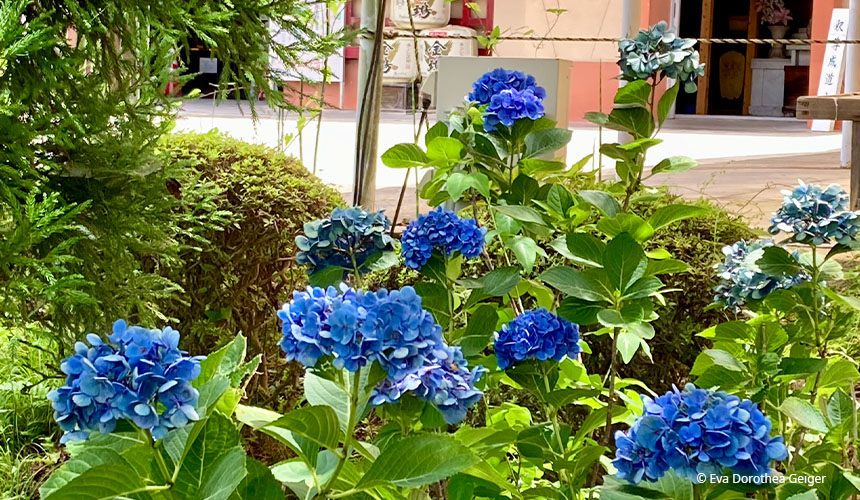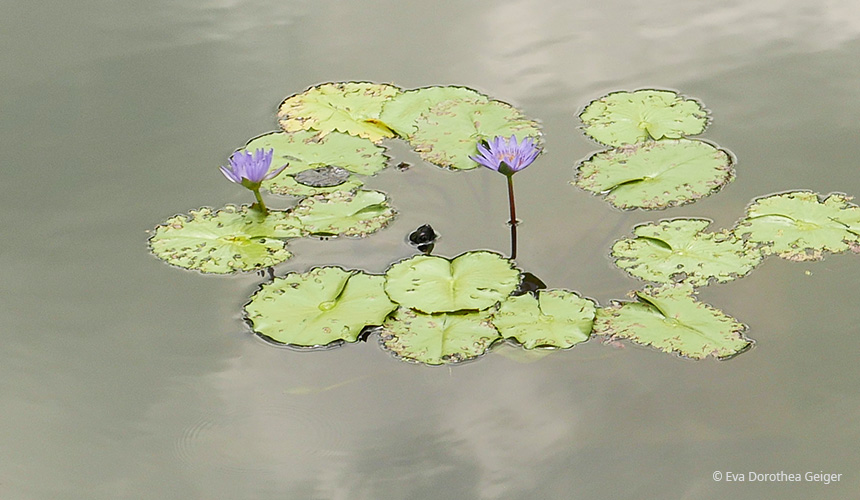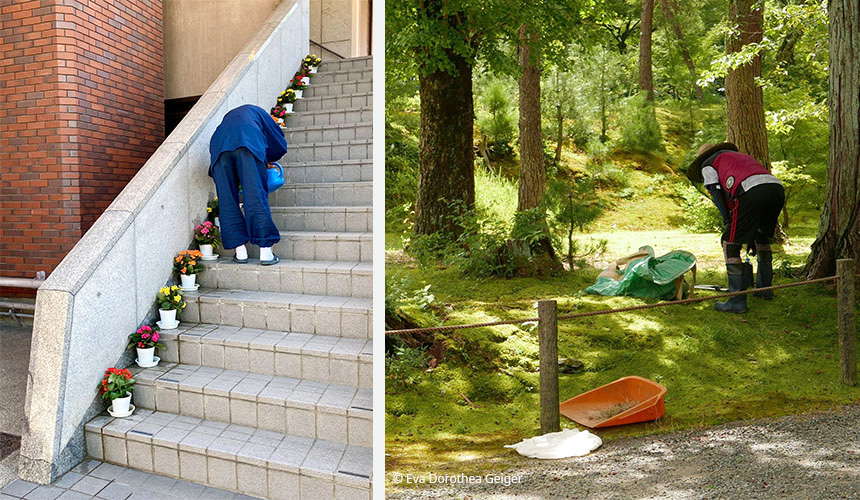
During summer, Japan displays a lush variety of plants and flowers that transform the country into a colorful and vibrant landscape. The hot and humid season, which lasts from June to August, offers ideal growing conditions for many plant species, which not only characterize nature but also cultural life in Japan.

One of the most famous plants of the Japanese summer is the hydrangea/ hydrangea, called ajisai in Japanese. These flowers bloom from June, often during the rainy season (tsuyu), and their colors vary from white to blue to purple, depending on the acidity of the soil. Hydrangeas can be found in many Japanese gardens and temples, where they are prized for their beauty and ability to survive the changeable weather.

Water lilies, known as suiren in Japanese, have both cultural and aesthetic significance in Japan. This elegant aquatic plant, which thrives in tranquil ponds and lakes, is prized in Japan for its tranquil beauty and symbolic associations.

Water lilies are a common sight in traditional Japanese gardens, where they are often planted in ponds that form the centerpiece of these carefully designed landscapes. The graceful way in which water lilies float on the surface of the water and open their flowers embodies the Japanese aesthetic of wabi-sabi, which honors the beauty of the simple and ephemeral. Water lilies, with their delicate flowers and large, round leaves, create an atmosphere of calm and serenity that is sought after in Japanese gardens.

In Buddhist-influenced gardens and temples, the water lily can promote contemplation and meditation by creating a peaceful environment. Its connection to water, which in Japanese culture represents purity and the constant movement of life, reinforces this spiritual significance. It is a popular motif in Japanese art, especially in paintings and ukiyo-e prints. Artists often use the water lily to create scenes of tranquil nature that evoke a deep emotional and spiritual resonance.

However, water lilies are not only found in Japanese art; the famous painting 'Water Lilies' by Claude Monet (1840 - 1926) is also reminiscent of a Japanese garden, because although Monet never visited Japan, he admired Japanese prints and, like many of his fellow Impressionists, was heavily influenced by them. Fascinated by the Japanese aesthetic, he created a water lily pond and built Japanese-style bridges in his garden, which he depicted on canvas in numerous paintings.

The leopard flower or Iris domestica is a plant species from the subgenus Hermodactyloides in the iris genus (Iris) within the iris family (Iridaceae). The German species name comes from the dark spots on the flowers, which are vaguely reminiscent of leopard skin. It is native to South and East Asia (Japan, China, Taiwan and North India).
With its small white flowers, Pollia japonica, known as East Asian Pollia (English), Yabumyoga in Japanese and d'ru' in Chinese, is a perennial flowering plant from East Asia. Its habitat is forests from 0-1200 m altitude. Its main distribution is in the tropics of the Old World, in East Asia and also in Taiwan, and it is also found in Japan and Korea.
Lagerstroemia indica, commonly known as a curling myrtle (also crepe myrtle, cream myrtle or crepe flower), is a species of flowering plant in the genus Lagerstroemia of the family Lythraceae and flowers in light or dark pink hues and also in white. It originates from China and is often a multi-stemmed deciduous tree with a broad, flat, rounded or even sprawling open habit. The tree is a popular breeding shrub for songbirds and wrens.

Hibiscus syriacus (garden hibiscus) originates from South East Asia and is mainly found in the temperate and subtropical regions of South East Asia such as China, Japan and India. It belongs to the mallow family (Malvaceae). It grows mainly at the edge of streams and rivers and in damp forests. As a garden plant, Hibiscus syriacus is available in many varieties with different flower colors.

Summer in Japan - like in Europe - is a time of intensive garden maintenance, as the plant world is in full bloom. Many Japanese dedicate themselves to tending their gardens to enjoy the beauty of nature during the hot months. However, it is often so hot that gardeners in the west work with built-in fans.

During this time, there are also many Hanamatsuri flower festivals, which celebrate the seasonal plants. The Japanese summer is rich in plant diversity, which characterizes both the nature and culture of the country. From the bright blooms of hydrangeas, lotus or water lilies to the cool, green leaves of maples, plant life plays a central role in Japan's summer landscape and is deeply rooted in the Japanese way of life and aesthetics. Not only can you admire the blooming colors in the landscape, Japanese women also wear their kimonos with motifs of the corresponding season, such as the lady in the UNESCO World Heritage districts of Higashiyama and Gion, which were also locations for the film 'The Geisha'.
Floral patterns are particularly common on kimonos. Each flower has its own meaning, which is often associated with the seasons or certain events in life. The Asanoha pattern (hemp leaf) or the Seigaiha pattern (waves) have protective or auspicious meanings. The colors of the kimonos are also meaningful. Red often stands for happiness and joy, while blue symbolizes purity and tranquillity. Gold and silver are often used for festive or formal occasions and lend the kimono a special splendor.